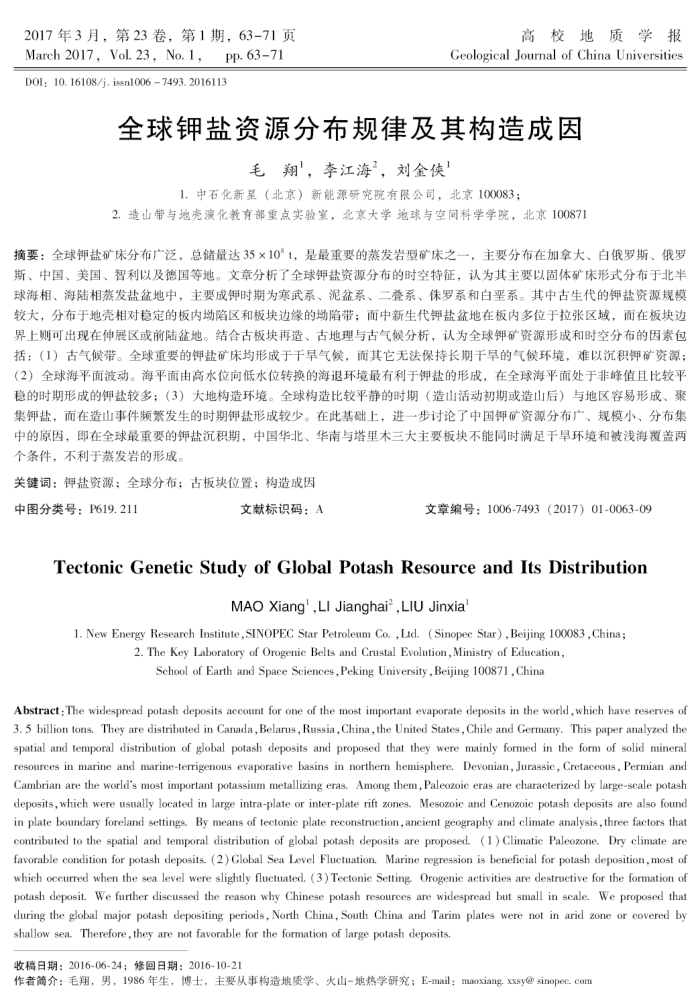您当前的位置:首页>论文资料>全球钾盐资源分布规律及其构造成因
内容简介
 2017年3月,第23卷,第1期,63-71页
2017年3月,第23卷,第1期,63-71页pp.6371
March2017,Vol.23,No.1,1 D0I: 10. 16108/j. issnl006 7493. 2016113
高校地质学报
Geological Journal of China Universities
全球钾盐资源分布规律及其构造成因
毛翔,李江海,刘金侠
1.中石化新星(北京)新能源研究院有限公司,北京100083;
2.造山带与地壳演化教育部重点实验室,北京大学地球与空间科学学院,北京100871
摘要:全球钾盐矿床分布广泛,总储量达35×101,是最重要的蒸发岩型矿床之一,主要分布在加拿大、白俄罗斯、俄罗斯、中国、美国、智利以及德国等地。文章分析了全球钾盐资源分布的时空特征,认为其主要以固体矿床形式分布于北半球海相、海陆相蒸发盐盆地中,主要成钾时期为寒武系、泥盆系、二叠系、保罗系和白垩系。其中古生代的钾盐资源规模较大,分布于地壳相对稳定的板内坳陷区和板块边缘的坳陷带;而中新生代钾盐盆地在板内多位于拉张区域,而在板块边界上则可出现在伸展区或前陆盆地。结合古板块再造、古地理与古气候分析,认为全球钾矿资源形成和时空分布的因素包括:(1)古气候带。全球重要的钾盐矿床均形成于干旱气候,而其它无法保持长期干旱的气候环境,难以沉积钾矿资源;(2)全球海平面波动。海平面由高水位向低水位转换的海退环境最有利于钾盐的形成,在全球海平面处于非峰值且比较平稳的时期形成的钾盐较多:(3)大地构造环境。全球构造比较平静的时期(造山活动初期或造山后)与地区容易形成、聚集钾盐,而在造山事件频繁发生的时期钾盐形成较少。在此基础上,进一步讨论了中国钾矿资源分布广、规模小、分布集中的原因,即在全球最重要的钾盐沉积期,中国华北、华南与塔里木三大主要板块不能同时满足千旱环境和被浅海覆盖两个条件,不利于蒸发岩的形成。
关键词:钾盐资源;全球分布;古板块位置;构造成因
中图分类号:P619.211
文献标识码:A
文章编号:1006-7493(2017)01-0063-09
TectonicGeneticStudyofGlobalPotashResourceandItsDistribution
MAO Xiang',LI Jianghai’,LIU Jinxia
1. New Energy Research Institute,SINOPEC Star Petroleum Co. ,Lid. (Sinopee Star) , Beijing 100083 , China :
2. The Key Laboratory of Orogenic Belts and Crustal Evolution, Ministry of Education,
School of Earth and Space Sciences,Peking University, Beijing 100871, China
Abstract: The widespread potash deposits account for one of the most important evaporate deposits in the world,which have reserves of 3. 5 billion tons. They are distributed in Canada, Belarus, Russia, China, the United States , Chile and Germany. This paper analyzed the spatial and temporal distribution of global potash deposits and proposed that they were mainly formed in the form of solid mineral resources in marine and marine-terrigenous evaporative basins in northem hemisphere. Devonian, Jurassic, Cretaceous, Permian and Cambrian are the world's most important potassium metallizing eras. Among them, Paleozoic eras are characterized by large-seale potash deposits, which were usually located in large intra-plate or inter-plate rift zones. Mesozoic and Cenozoic potash deposits are also found in plate boundary foreland settings. By means of tectonic plate reconstruction, ancient geography and climate analysis, three factors that contributed to the spatial and temporal distribution of global potash deposits are proposed. (1) Climatic Paleozone, Dry climate are favorable condition for potash deposits. (2) Global Sea Level Fluctuation. Marine regression is beneficial for potash deposition, most of which oceurred when the sea level were slightly fluctuated. (3) Tectonic Setting. Orogenic activities are destructive for the formation of potash deposit. We further discussed the reason why Chinese potash resources are widespread but small in scale. We proposed that during the global major potash depositing periods, North China, South China and Tarim plates were not in arid zone or eovered by
shallow sea. Therefore,they are not favorable for the formation of large potash deposits. 收稿日期:2016-06-24;修回日期:2016-10-21
作者简介:毛翔,男,1986年生,博士,主要从事构造地质学、火山-地热学研究;E-mail:maoxiang.xxsy@sinopec.com